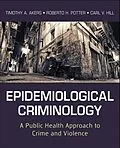Epidemiological Criminology: A Public Health Approach to Crimeand Violence Epidemiological Criminology offers an introduction to thesources and methods of epidemiological criminology and shows how toapply these methods to some of the most vexing problems nowconfronting researchers and practitioners in public healthepidemiology, criminology, and criminal justice. The book describes, explains, and applies the newly formulatedpractice of epidemiological criminology, an emerging disciplinethat finds the intersection across theories, methods, andstatistical models of public health with their corresponding toolsof criminal justice and criminology. The authors show how to applyepidemiological criminology as a practical tool to addresspopulation issues of violence and crime nationally and globally. Inaddition, they look at future directions and the application ofthis emerging field in corrections, public health and law, gangsand gang violence, victimology, mental health and substance abuse,environmental justice, international human rights, and globalterrorism. For students, the book presents an exciting approach tounderstanding epidemiology as a means with which to tackle some ofthe worst problems for vulnerable populations. For researchers andpolicymakers, the book offers a new methodological perspective thatrecognizes the significance of social disparities and the builtenvironment as factors in the formulation of public health policy,and provides a tool with which to produce more effectiveinterventions, preventive measures, and policy formulations.
Autorentext
Timothy A. Akers, M.S., Ph.D., is a professor of public health and associate dean for graduate studies and research in the School of Computer, Mathematical and Natural Sciences and director of the Center for Health Informatics, Planning and Policy at Morgan State University in Baltimore, Maryland.?
Roberto H. Potter, Ph.D., is the director of research partnerships at the Department of Criminal Justice, College of Health and Public Affairs at the University of Central Florida.
Carl V. Hill, M.P.H, Ph.D., is a health scientist administrator and contract officer's representative with the National Institutes of Health, Eunice Kennedy Shriver National Institute of Child Health and Human Development.?
Klappentext
Epidemiological Criminology: A Public Health Approach to Crime and Violence
Epidemiological Criminology offers an introduction to the sources and methods of epidemiological criminology and shows how to apply these methods to some of the most vexing problems now confronting researchers and practitioners in public health epidemiology, criminology, and criminal justice.
The book describes, explains, and applies the newly formulated practice of epidemiological criminology, an emerging discipline that finds the intersection across theories, methods, and statistical models of public health with their corresponding tools of criminal justice and criminology. The authors show how to apply epidemiological criminology as a practical tool to address population issues of violence and crime nationally and globally. In addition, they look at future directions and the application of this emerging field in corrections, public health and law, gangs and gang violence, victimology, mental health and substance abuse, environmental justice, international human rights, and global terrorism.
For students, the book presents an exciting approach to understanding epidemiology as a means with which to tackle some of the worst problems for vulnerable populations. For researchers and policymakers, the book offers a new methodological perspective that recognizes the significance of social disparities and the built environment as factors in the formulation of public health policy, and provides a tool with which to produce more effective interventions, preventive measures, and policy formulations.
Inhalt
Figures and Tables xi
Preface xiii
Acknowledgments xxiii
The Authors xxix
Introduction: Crime, Criminal Justice, Health, and Victims xxxiii
Levels of Theoretical Analysis xxxiv
Why the Meso Is Important xxxvii
Revising the Epidemiological Trinity xliii
Hosts, Agents, Agency, and Behavior xlviii
Risk, Deviance, Crime, and Health l
Summary lv
Part One Foundation for An Emerging Paradigm: Epidemiological Criminology
Chapter 1 Establishing a Historical Framework for Epidemiological Criminology 3
The War on Poverty 6
The War on Crime 11
The War on Drugs 18
The War on Terror 22
Conclusion 24
Summary 24
Chapter 2 Where Two Worlds Collide: Toward an Integrated Theory of Epidemiological Criminology 27
Roots and Forks in the Road 28
History 29
Determining When or Where to Start an Investigation 31
Defining an Emerging Paradigm 35
Epidemiological Criminology 47
Conclusion 50
Summary 52
Chapter 3 The Lexicon of Terminology: Developing an Emerging Paradigm 57
Scientific and Practice Integration: Building an Emerging Paradigm 59
Theories and Models: An Integrative Paradigm 60
Theories and Models: Framing the Paradigm 64
Units of Analysis 68
Health and Crime: Biomedical and Behavioral Disparities 69
Prevention Interventions 70
Causation: The Epidemiologic Triad 72
Conclusion 73
Summary 73
Part Two Theories, Concepts, and Methods
Chapter 4 Criminology, Criminal Justice, and the Social Sciences 79
Criminology 79
Criminal Justice 80
Where Does That Leave Epidemiological Criminology? 81
Public Health 82
Lessons from the Foundation of Sociology 89
Conclusion 92
Summary 92
Chapter 5 Research Methods in Epidemiology and Criminology: A Bridge Between? 95
Surveillance or Monitoring? 96
Monitoring, Surveillance, and Epidemiological Criminology 99
Method, Technique, and Theory 100
The Evidence Base 102
In the Field and on the Streets 103
Conclusion 104
Summary 104
Chapter 6 Integrating the Interdisciplinary Sciences: Theoretical Foundations of the Epidemiological Criminology Framework 107
Criminogenics: The Evidence Base of Individual Criminal Behavior 108
Propensity Versus Typology: How Changeable Are Criminogenics? 109
Dynamic Risks 110
Implications for Public Health Interventions 113
Social Learning and Social Structure: Moving Evidence to the Next Social Levels 113
Epidemiological Criminology Implications for Public Health Interventions 118
Conclusion 121
Summary 122
Part Three Applying Epidemiological Criminology In Practice And Policy
Chapter 7 Health Disparities and Epidemiological Criminology 129
Health Disparities 132
Conceptualizing Criminogenic Health Disparities 137
Conceptualizing Epidemiological Criminology and Disparities 141
Conclusion 143
Summary 144
Chapter 8 Incarceration and Epidemiological Criminology 147
The Organizational Ecology of Incarceration 149
Incarceration by Police 152
Juvenile Detention: A Snapshot 155
The Process of Incarceration 156
The Epidemiology of Incarceration: The Importance of Process 162
Criminal Records 164
Conclusion 166
Summary 166
Chapter 9 The Health of Correctional Populations 169
Competing Images: Magic Castles and Houses of Horror 169
Juvenile Detention 171
Jail 172
Health of Jail Inmates 173
Health of Prisoners 176
HIV: An Exemplar of Where One Looks and How 178
Reentry to the Community 190
Implic…
